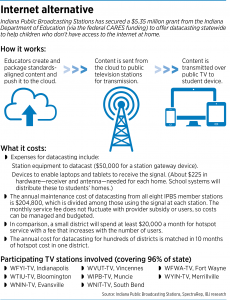Subscriber Benefit
As a subscriber you can listen to articles at work, in the car, or while you work out. Subscribe NowIt’s not often that an older form of communication fills a gap a newer form cannot.
But that’s exactly the case when it comes to an initiative led by a coalition of eight public television stations in Indiana.
Indiana Public Broadcasting Stations, a not-for-profit coalition founded in 1979, recently secured two grants totaling $6.73 million from the Indiana Department of Education—via the federal CARES Act—to offer what’s called datacasting statewide. The goal is to give children who don’t have at-home internet a way to receive instruction and other educational information from their schools.
Indiana is only the second state in the U.S. to use datacasting to deliver educational content.
South Carolina Educational TV was the first to launch its educational datacasting initiative this fall, and Indiana was close behind. Since Indiana started, Pennsylvania PBS also has received funding to launch datacasting. The three organizations have formed a coalition and are now communicating regularly about their implementation efforts.

Mark Newman, Indiana Public Broadcasting Stations executive director, is credited with coming up with the idea to utilize datacasting for Indiana schools and their students.
“Mark is a forward-looking, visionary guy. It comes down to leadership, and Mark has charged forward to get a solution for the school children,” said Mark O’Brien, president and co-founder of Washington D.C.-based SpectraRep, the nation’s leading maker and seller of datacasting equipment and also a service provider.
Datacasting allows school administrators and teachers to send encrypted content, including lectures, handouts, test scores, grades and other information, to students using existing TV broadcast infrastructure. Stations can use a small slice of existing spectrum to transmit the content without impacting their regular TV broadcasts.
Students need a computer, antenna and receiver to participate. No internet is required, but the information is viewed through a platform that is similar to a web browser.
The signal enters the home over the air, bypassing the need for traditional Wi-Fi, and is free of charge to the user. The information can be encrypted for security—so only the intended recipient can receive it.
Datacasted content can be targeted to individuals or small and large groups. While the datacasted content can be sent live, much of the early programming will be recorded because it’s difficult to scale live datacasted content, industry experts said. Multiple children in a single household, however, can view different datacasted material simultaneously.
The biggest downside to datacasting is that it’s currently a one-way form of communication, which means students and parents can’t send questions or comments back to their teachers or school officials through datacasting. Two-way communication is being worked on and is possible in the future, industry experts said.
Critical for rural and poor students

Despite that considerable shortcoming, datacasting is seen as a significant solution for the one-third of at-home students who don’t have internet, either because they’re in an area that is too rural to have it or their household can’t afford it.
Public TV stations—including WFYI-TV Channel 20 in Indianapolis, WTIU-TV Channel 30 in Bloomington and WIPB-TV Channel 49 in Muncie—have joined the effort to disseminate the content. The state’s eight public TV stations cover 96% of the state, which means educational information can be disseminated widely.
“Because of the at-home learning piece involved, it was a natural fit for us,” said Rob Anderson, WTIU’s interim executive director. “We as a public broadcast station could help our members and viewers within the WTIU footprint. We have a lot of rural communities in our footprint, and it’s part of our mission to serve them. It’s a way for us to help people battle their internet desert situation.”
The newly implemented system is being piloted later this month in Jennings County, about 70 miles south of Indianapolis.
IPBS was initially awarded $1.38 million for the Jennings County School Corp. pilot project and another $5.35 million to take the project statewide.
The datacasting signal is set to start emanating from WTIU in the third week of November. IPBS plans to start testing signal reception in late November. Receivers will be distributed for testing purposes in December. Broad-based distribution of the datacasted signal will begin in January in Jennings County, with the rest of the state following soon after, Newman said.

“Last spring, the need for technology for connectivity became huge for us,” Jennings County School Superintendent Teresa Brown told IBJ. “We knew we needed to do some problem solving.”
Brown said 30% of the district’s students “have no or very limited [internet] connectivity. There are areas where there is nothing available. And 65% of our students qualify for free or reduced-cost lunch. It’s 85% in some areas. If you add in financially disadvantaged people, the 30% [who don’t have internet access] is low.”
More than 84,000 school-aged Hoosier children live in homes without internet connections, according to state figures. The figure is even greater if you add households with unstable or data-capped service, Newman said.
It’s not just rural school corporations that will benefit from datacasting, Newman explained.
“Datacasting is a solution for urban and rural school districts. It’s definitely going to be very useful in places like Indianapolis. … We have [an] existing network of TV network towers all over the state. The infrastructure is in place.”
Old technology, new idea
 The idea of datacasting isn’t new. In fact, it uses television infrastructure that has been in place for more than 50 years.
The idea of datacasting isn’t new. In fact, it uses television infrastructure that has been in place for more than 50 years.
“Datacasting as a technology is very mature,” WTIU’s Anderson said. “It’s been around a number of years, but principally focused on the public safety space by homeland security and local police teams. It’s been used to send video and blueprints and maps to police in their cars.”
Jennings County Schools’ Brown had never heard of datacasting last spring as the pandemic began sweeping across the nation.
“We didn’t know anything about it,” she said. “We became very aggressive in terms of looking for solutions. We talked to everybody. When we talked to Mark Newman, we became very excited. This is very innovative, but it’s already there. It’s a community resource.”
Jennings County has continued to deal with at-home learning this fall—including some total school closures due to the pandemic.
What’s the cost?
There are costs to datacasting. That’s where the CARES grant comes in, Newman explained.
A receiver and antenna that cost $225 are needed for each home receiving the datacasted signal, O’Brien said. But, he added, there is no monthly service fee.
“The biggest cost is the purchase and distribution of household receivers and antennas,” Newman said. There will be 8,000 receivers—about 1,000 for each participating station viewing area—initially distributed as part of Indiana’s datacasting initiative.
Each participating station will need a gateway device to send out the signal. Each one costs $50,000, O’Brien said. “That’s the box that allows information to be scaled to serve thousands of teachers and hundreds of thousands of students,” O’Brien said. “A single gateway device could handle a school or even school corporation of any size.”
The annual maintenance cost of datacasting for all eight IPBS member stations combined is projected at $204,800, according to IPBS.
But the cost of datacasting remains much lower than the cost of internet hot spots.
“We’re the backup plan to broadband. Not only do you have to buy the hotspots [for broadband], but you have to pay the monthly fee,” O’Brien said.
A single hot spot costs $200 to $250, and the cellular plan needed to go with it costs $30 to $50 per month, depending on the discount the user gets.
The annual cost for datacasting for hundreds of districts is matched in 10 months of the hotspot cost in one district, Newman said.
And once the datacasting technology is in place, “it can be used for as long as it doesn’t wear out,” he added. “It can be years and years.”
While the need for datacasting was brought on by the coronavirus pandemic, educators and broadcasters agree there will be a need for remote learning long after the pandemic wanes.
“Someday the schools will reopen and the pressure we’re under right now will be relieved. But this issue isn’t going to go away,” O’Brien said. “When this is all over, there’s going to be a new reality where working from home will be normal, natural and expected. I think the same is the case for schools.
“I think snow days are something you might be able to tell your grandkids used to exist,” he said. “If you don’t have broadband, you are going to fall further behind. In that scenario, datacasting can make a huge difference. This is the most practical solution for people without broadband anyone has come up with so far.”
Once datacasting infrastructure is in place, it will fill numerous needs, Anderson said.
“There are lots of other applications for datacasting: telemedicine, agricultural applications, adult education, just to name a few,” he said. “The things we learn from this pilot are going to be immense, and we’ll be able to leverage those with other business and community sectors.”•
Please enable JavaScript to view this content.
